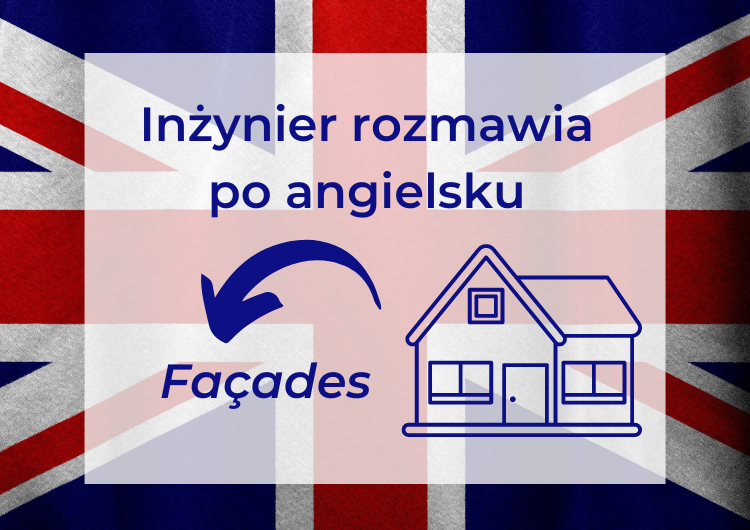– Good morning. We’ve had an appointment to talk about installing the house façade.
– You’ve found the right guy. We’ve got massive experience in the industry. Are you interested in installing the façade alone or would you like to have the wall thermal insulation done as well?
– Both. I’d like to recover some of the costs under the thermal insulation allowance.
– All clear. There are two methods of performing the work – wet or dry. Different types of façades are used with each of them.
– Please give me some details of these methods.
– The wet method involves attaching the insulation material to the wall with glue and dowels, applying an adhesive layer over the mesh, priming and finishing with a thin-coat plaster. The latter method involves making a suitable wooden or steel grate and then fixing the outer layer of the façade to it in the form of wooden or plastic panels, as well as various cladding panels.
– Let’s focus on the wet method. This is also what the technical design provides for, according to which we should use 15 cm thick graphite polystyrene for insulation, and the plaster should be in a shade of grey. Let’s talk about the types of plasters, their texture and appearance.
– We strive to use system solutions that guarantee the aesthetic appearance and protection of the plaster against external factors. Among the basic structures of thin-coat plaster we distinguish the so-called “pitted skin texture” and “knockdown texture”. We can make mineral, silicone, silicate, silicone-silicate plasters.
– Are there any conditions for using these plasters?
– Yes, they might be used depending on where our house is located. Whether it’s downtown on a busy, dusty street, or whether the house is located by a body of water, surrounded by lots of trees. The different types of plasters differ in durability, vapour permeability, susceptibility to staining, water repellent properties, resistance to fungi and lichens.
– When can you start applying the plaster?
– You need to prime the substrate with a plaster primer to adjust absorbency. It is best to tint the primer to a colour similar to that of the plastering compound. Th is will protect the façade from stains and discolouration.
– What else to pay attention to when doing plastering?
– Proper application and trowelling of the plaster is very important. The appearance of the plaster in terms of evenness and the required texture depends on this. All imperfections and errors will be visible to the naked eye.

Elewacje
– Dzień dobry. Byliśmy umówieni, żeby porozmawiać o wykonaniu elewacji domu.
– Dobrze pan trafił. Mamy ogromne doświadczenie w tej branży. Interesuje pana wykonanie samej elewacji, czy w grę wchodzi również docieplenie ścian?
– To i to. Zależy mi, żeby odzyskać część kosztów z tytułu ulgi termoizolacyjnej.
– Wszystko jasne. Wyróżnia się dwie metody wykonania prac – mokrą lub suchą. Przy każdej z nich stosuje się inne rodzaje elewacji.
– Proszę przybliżyć mi te metody.
– Metoda mokra polega na przymocowaniu materiału izolacyjnego do ściany za pomocą kleju i kołków, wykonaniu warstwy klejowej na siatce, zagruntowaniu i wykończeniu tynkiem cienkowarstwowym. W przypadku drugiej metody należy wykonać odpowiedni drewniany lub stalowy ruszt, a następnie zamocować do niego zewnętrzną warstwę elewacji w postaci paneli drewnianych lub plastikowych, a także różnych płyt okładzinowych.
– Skupmy się na metodzie mokrej. Tak też przewiduje projekt techniczny, według którego do ocieplenia powinniśmy wykorzystać styropian grafitowy o grubości 15 cm, a tynk powinien być w odcieniu szarości. Porozmawiajmy o rodzajach tynków, ich strukturze i wyglądzie.
– Staramy się stosować rozwiązania systemowe, które gwarantują estetyczny wygląd i ochronę tynku przed czynnikami zewnętrznymi. Wśród podstawowych struktur tynku cienkowarstwowego wyróżniamy tzw. kornik i baranek. Możemy wykonać tynki: mineralne, silikonowe, silikatowe, silikonowo-silikatowe.
– Czy są jakieś uwarunkowania zastosowania tych tynków?
– Tak, ich stosowanie zależy od tego, gdzie znajduje się nasz dom. Czy jest to centrum miasta przy ruchliwej, zakurzonej ulicy, czy też dom położony jest nad zbiornikiem wodnym, w otoczeniu dużej ilości drzew. Poszczególne rodzaje tynków różnią się trwałością, paroprzepuszczalnością, podatnością na zabrudzenia, właściwościami hydrofobowymi, odpornością na grzyby i porosty.
– Kiedy można przystąpić do nakładania tynku?
– Trzeba zagruntować podłoże podkładem tynkarskim w celu wyrównania chłonności. Najlepiej zabarwić środek gruntujący na kolor zbliżony do koloru masy tynkarskiej. Zabezpieczy to elewację przed plamami i przebarwieniami.
– Na co jeszcze zwrócić uwagę przy wykonywaniu tynków?
– Bardzo ważne jest odpowiednie nanoszenie i zacieranie tynku. Od tego zależy jego wygląd pod względem równości i wymaganej struktury. Wszystkie niedoróbki oraz błędy będą widoczne gołym okiem.
Słowniczek Vocabulary
façade – elewacja
(wall) thermal insulation – docieplenie (ścian)
thermal insulation allowance – ulga termomodernizacyjna
glue – klej
dowel – kołek
adhesive layer – warstwa kleju
mesh – siatka
priming – gruntowanie
(thin-coat) plaster – tynk (cienkowastwowy)
cladding panel – płyta okładzinowa
polystyrene – styropian
durability – trwałość
vapour permeability – paroprzepuszczalność
susceptibility to… – podatność na…
resistance to… – odporność na…
plaster primer – podkład tynkarski
to apply/trowel the plaster – nanosić/zacierać tynk
Użyteczne zwroty/Useful phrases
We’ve had an appointment. – Byliśmy umówieni.
You’ve found the right guy. – Dobrze pan trafił.
We’ve got massive experience in the industry. – Mamy ogromne doświadczenie w branży.
Are you interested in (installing the façade)? – Czy interesuje pana (wykonanie elewacji)?
I’d like to recover some of the costs. – Chciałbym odzyskać część kosztów.
All clear. – Wszystko jasne.
There are two methods (of performing the work). – Są dwie metody (wykonania prac).
Please give me some details. – Proszę przybliżyć mi szczegóły.
Let’s focus on… – Skupmy się na…
Are there any conditions for using (these plasters)? – Czy są jakieś uwarunkowania zastosowania (tych tynków)?
(They) differ in… – Różnią się one…
It will protect (the façade) from (stains). – To zabezpieczy (elewację) przed (plamami).
What (else) to pay atention to? – Na co (jeszcze) zwrócić uwagę?
All imperfections will be visible to the naked eye. – Wszystkie niedoróbki będą widoczne gołym okiem.
Przygotowała Magdalena Marcinkowska




